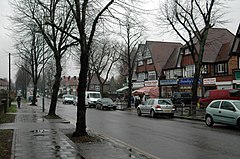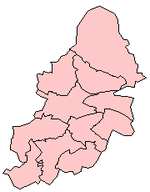Hall Green
| Hall Green | |
|---|---|
| File:BirminghamHallGreen.png Hall Green constituency shown within Birmingham. | |
 Independent businesses in a shopping area of Hall Green | |
| Population | Expression error: "25,921 (2001 Population Census)" must be numeric |
| Metropolitan borough | |
| Metropolitan county | |
| Region | |
| Country | England |
| Sovereign state | United Kingdom |
| Post town | BIRMINGHAM |
| Postcode district | B28 |
| Dialling code | 0121 |
| Police | West Midlands |
| Fire | West Midlands |
| Ambulance | West Midlands |
| UK Parliament | |

Hall Green is an area and ward in south Birmingham, England. It is also a council constituency, managed by its own district committee.
Politics
Birmingham, Hall Green is a parliamentary constituency; its Member of Parliament is Stephen James McCabe. Hall Green ward is presently represented by three Liberal Democrat councillors on Birmingham City Council; Sandra O'Brien, Paula Smith and Michael Wilkes.
Hall Green has adopted a Ward Support Officer with the current holder of the title being Talbinder Kaur.
Population and housing
The 2001 Population Census found that there were 25,921 people living in Hall Green with a population density of 4,867 people per km², this compares with 3,649 people per square KM for Birmingham. Hall Green is below average, when compared to Birmingham in general, in the percentage of population represented by ethnic minorities with the figure for Hall Green being 25.4% (6,580) and the figure for Birmingham being 29.6%.
Housing is largely inter-war (mainly semi-detached) and pleasantly laid out with tree-lined roads and green spaces. There are still a good number of independent locally run shops.
Facilities
There is a popular Greyhound racing stadium and race course situated on York Road called "Hall Green Stadium", though this is technically just across the border in neighbouring Acocks Green. The stadium has won the BGRB Midlands and Western Region Racecourse of the Year 2003 award for the 4th consecutive year.
Hall Green was also home to Moor Green F.C., but the club is now known as Solihull Moors after a merger with Solihull Borough due to an arson attack in 2005 on the Moorlands stadium.[1]
The area is served by Hall Green Library, which was opened in 1962.[2]
St John's Church in Sparkhill is the Anglican Church whose parish covers the northern part of this district.
Hall Green railway station is on the Birmingham to Stratford Line. It opened in 1908.
Architecture

On School Road is the Church of the Ascension, formerly the Job Marston Chapel. Built in 1704, it is believed to have been designed by Sir William Wilson. The chancel and transepts were added in 1860. The brick building consists of an exterior with a stone entablature and balustrade supported by Doric pilasters and the window architraves are of moulded stone. At the west end is a tower with an octagonal upper storey with a copper cupola. The interior of the nave is covered by a coved plaster ceiling. It is the earliest classical church to survive within the city boundary.[3]
Other historic buildings in Hall Green include Sarehole Mill, one of only two watermills in the city.
Highfield House is another historical building. It was built in 1850, making it the oldest house and the third oldest building in Hall Green. It was the farm house for Highfield Farm. The house was built in Georgian style with beautiful Neo-Classical features. It also retains the original sash windows. The demolition of the locally listed building has been proposed by developers, who want to build homes on the surrounding land. The ground floor of the house still has its wooden shutters fitted to the inside of each window frame which were closed and secured at night. The present day use for these shutters was to keep the house warm at night as they were very effective for excluding draughts but their original purpose was one of fortification against attack. When the house was built many isolated houses were a target for burglars, brigands and armed assault.Sadly, in March 2008 and in the face of much public opposition, petitions, articles in local newspapers and items on radio stations, Birmingham Council's Planning Committee approved plans for its demolition and the building of four houses and six apartments.
As well as this is Petersfield Court, an Art Deco housing block containing 14 flats, built in 1937. Built out of brick, it has rounded corner windows, made possible by the introduction of reinforced concrete.[3] Later examples of architecture include the original Hall Green Technical College on the Stratford Road. It was designed by S. T. Walker and Partners in association with Alwyn Sheppard Fidler, the City architect for Birmingham. Built in 1958, it consists of a reinforced concrete framed classroom and an administration block clad with cedar boards and aluminium windows. Boarding was rarely used on educational buildings of this size at the time.[3]
A private development named "The Hamlet" was built between 1883 and 1893. It consists of fourteen villas on Hamlet and Fox Hollies Roads, along with the Friends Meeting House on the Stratford Road. The Architectural style of these brick and tile properties is tipified by massive chimneys and timbers, leaded casements, and bracketted bays. It is believed that initially all the properties carried a moulded plaque bearing the initials 'MS' along with the date of construction but few of these plaques now remain. Whilst there is not a definite explanation for the 'MS' monogram the most likely interpretation is that they stand for Marian Severne whose families land they were built on.
Famous residents
Hall Green has been a home to comedian Tony Hancock, who lived at 41 Southam Road until the age of three (the house contains a plaque commemorating this), racing commentator Murray Walker, who was born at 214 Reddings Lane (which is now a dentist), Nigel Mansell, who though born in Upton-upon-Severn spent most of his childhood and early adult years in the area and most famously J. R. R. Tolkien, who lived near Sarehole Mill, Birmingham's only working water mill. Sarehole Mill is a tourist attraction, powered by the River Cole, that is open to visitors during the summer months and has several locations nearby that are supposedly the inspiration behind scenes in The Hobbit and The Lord of the Rings. The area of Hall Green was not developed at the time when Tolkien lived there (1896—1900).
The Shire Country Park
The Shire Country Park runs past Sarehole Mill and along the course of the River Cole to Small Heath. Millstream Way passes through the park. Wildlife present at the country park include otters and water voles and many types of birds. The old village of Sarehole (now on the border of Hall Green and Moseley) is where J.R.R. Tolkien lived as a child and gained inspiration for the Hobbits home "The Shire".
References
- J R R Tolkien - A Biography, Humphrey Carpenter ISBN 0-261-10245-1
- Hall Green Community Network pages
- Birmingham City Council: Hall Green Constituency
- Birmingham City Council: Hall Green Ward
- Photographs Hall Green
- Greyhound racing in Hall Green
- Made in Birmingham
- Moor Green FC
- Hall Green School

